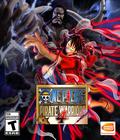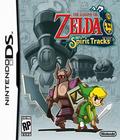The Legend of Zelda: Spirit Tracks opens up a while after the events in The Legend of Zelda: Phantom Hourglass. The Zelda and Link who starred in that game have long since stepped out of the spotlight, and peace reigns over their small country. The nation is prospering due to the discovery of Spirit Tracks, a magical set of railroad tracks that spans the entire land. Thanks to the existence of these railways, train travel has become the country's new mode of transportation, and engineers are held in high regard. These rails also bind an evil demon who was sealed under the country long ago.
Players join a new Link, who is now an apprentice conductor, as he prepares to take his test to become a full-fledged engineer. No sooner does Link pass the test than everything goes south. The evil Chancellor Cole destroys the Spirit Tracks and kidnaps Princess Zelda to serve as a host for the evil demon. Naturally, Link is the only one who can stop him, and this time, he has a little help. All Cole needed was Zelda's body, so he used magic to eject Zelda's spirit, trapping the princess as a ghost that only Link can see. She's his constant companion on the journey, and together, the duo must resurrect the Spirit Tracks and prevent Cole from completing his evil scheme.
Spirit Tracks may not have a deep or complex plot, but it makes up for that by being a very heartfelt game. It's cheerful, funny and well-written, and there are enough cute references and callbacks to previous Zelda games to warm the hearts of even the most die-hard fans. The real star is Princess Zelda, who does all the talking in place of the mute Link. Rather than the usual demure, mysterious princess seen in games like Twilight Princess and Zelda 64, this version of Zelda is a lot more energetic and amusing. Much like Midna in Twilight Princess, she carries the game and actually outshines the main character. Considering the franchise is named after the character, it's nice to finally get a Zelda who can do something besides get kidnapped or wait around. Spirit Tracks even makes fun of this trope before launching into one of the game's funniest scenes.
As in the previous DS title, The Legend of Zelda: Spirit Tracks is controlled almost entirely with the touch-screen, aside from a few handy shortcuts bound to either the d-pad or DS face buttons, depending on which hand you use. You move Link by simply tapping where you want him to go. A double-tap will cause Link to roll, which is useful for dodging enemy attacks, although it can be a bit finicky at times. Attacking enemies is done by either tapping them with your stylus or drawing a "slashing" motion over the enemy. You can also perform Link's signature spin attack by drawing a circle around him. Investigating or using objects is done simply by tapping them. You can use an equipped item either by tapping an icon on the screen or by holding one of the shoulder buttons. Overall, Spirit Tracks' touch-screen controls are not bad. They're not as comfortable as using a regular control method, but they do the job adequately enough, and after a few minutes of gameplay, they'll feel quite natural. An option to use the d-pad would have been nice, but the lack of regular control becomes more understandable once you gain access to Link's many items.
As is the trademark of any good Zelda game, you'll begin your adventure with nothing to your name but a borrowed green tunic. As the story progresses, you'll get a bunch of neat items to explore dungeons. Items range from the traditional Zelda fare like bombs and shields to unique new gadgets that take advantage of the DS' features. For example, the Whirlwind lets you shoot gusts of wind, but instead of pressing a button, you activate the Whirlwind by blowing into the DS' microphone. My favorite new Zelda gadget is the whip. In a possible homage to Mother 3, the whip is actually a red snake, and you can use it to grapple onto objects, grab items or smack enemies by tapping them with the stylus. It's best used in sections where you have to quickly grapple from area to area. There's a good selection of items, but a little more variety would have been helpful since some items are recycled from the previous title. The game definitely does a good job of making interesting use of your gadgets.
While most of the items in Spirit Tracks are fun to use, a few stand out as rather aggravating, such as the aforementioned Whirlwind or the all-important Spirit Flute, because they make use of the DS' built-in microphone. Being forced to constantly blow on your DS to attack an enemy or play a tune is a cute idea, but because the DS microphone is so finicky, it becomes frustrating instead. There are times when the microphone will register two blows instead of one, or no blow at all, and I had a surprisingly difficult time getting it to reliably register my blowing without holding the DS right up to my face. I eventually got around this by tapping loudly on the microphone, but that's still far more awkward than simply pressing a button or sliding the stylus; even at the best of times, it's an uncomfortable method.
The real problem occurred when I tried to play the game anywhere but in a quiet, private location. The microphone picked up noises from around me and registered them as attempts to do something, which in turn messed up my flute-playing efforts, no matter which method I used. Considering that Spirit Tracks is a DS game, this severely limits its portability. The segments requiring the flute are fortunately few and far between, but it is aggravating to incorporate such a pointless feature for seemingly no other reason than to use every one of the DS' abilities. Depending on your DS model and your difficulty with these segments, the features can turn a fun and light game into something frustrating and aggravating.
As previously mentioned, Princess Zelda may have been kidnapped, but her spirit is still eager to help out. Zelda can't do much because she's incorporeal and incapable of interacting with the world. However, in certain areas of the game, you'll encounter suits of animate armor called Phantom Guardians, who are nearly invincible and can slay Link in a single hit. If you find a way to damage them, the spirits will be driven away and leave behind the empty suit. This is where Zelda's ghostly status comes in handy. She can possess one of these suits of armor and travel along with Link for a brief period. While in the armor, Zelda can wield a giant sword, and her huge, armored body can walk through spikes, block fireballs, and be a lot tougher and heavier than Link can ever be.
There are different kinds of Phantom Guardian bodies that Zelda can possess, so she can gain access to new powers like flaming swords or teleportation. To order Zelda around, you can ask her to follow Link or draw a path with the stylus. Her AI can be a bit brain-dead at times, but your ability to issue orders using the stylus quickly overcomes this. Some of the best moments in the game are when the duo is adventuring together, and I often wished that more dungeons used this mechanic.
The overall dungeon design in Spirit Tracks is fairly good. The dungeons are generally well put-together and interesting to visit, so perhaps the worst thing that can be said is that the dungeon design is pretty bland when compared to games like Link to the Past or The Minish Cap. There are some interesting puzzles spliced in here and there, but they're mostly workman-like Zelda dungeons. Some interesting puzzle designs crop up when Zelda and Link are working together, designs that just don't occur when Link is on his own. The boss fights were very intuitive but are rather easy to overcome.
Each area in the game is connected by the Spirit Tracks, which are railway tracks that a locomotive can traverse. In gameplay terms, they form routes from one area to the next, so instead of traveling by foot or horse across a giant overworld, you venture between areas by riding along the tracks in Link's Spirit Engine. You control the engine by using the stylus to trace the path that you wish to travel, and the engine will start moving. This process is mostly automated; Link can adjust the speed of the engine or occasionally select which fork in the path to follow, but that is about the sum total of his contribution.
Your time on the train will be spent watching out for obstacles that litter the track, such as farm animals, angry monsters and roaming bandits — and all wish to derail your train! Fortunately, you have a few ways to handle these annoyances. The whistle is equipped on your train, and you can use it by using the DS stylus to pull the whistle cord to scare off certain animals and enemies. You can also use the whistle to activate certain things hidden throughout the land. Your second weapon is your train's built-in cannon; you simply click on the enemy you wish to attack, and the super-accurate cannon will blast them to pieces. The only limitation is a split-second delay between shots, which makes a missed shot potentially deadly. Your train has humble beginnings, but you can upgrade it with new cars as the game progresses to make it more durable and attractive.
The Spirit Tracks are used to travel from location to location, but at the beginning of the game, they're mostly destroyed. In order to restore them, Link has to find railway maps hidden within the Spirit Temple. Once enough of the rails have been restored, people will request that Link take them places or complete missions for them. Finishing these missions can also restore areas of the rails, which in turn allow access to new side-quests or new routes that make it easier to get around. Transporting passengers is a slightly different experience from normal train travel, since the passengers expect you to obey the rules of the rails in order to have a safe, peaceful and law-abiding journey. If you take damage, slam on the brakes or ignore warning signs, they'll get angry at you. On the other hand, being a good conductor earns their favor, and this it's not difficult to accomplish. Players should avoid damage anyway, and the few warning signs ask you to occasionally blow the whistle or slow down for a short period of time. If you can remember when to slow down so you reach a station safely, you'll easily keep your passengers safe. Most of the fun with these side-quests is figuring out where people need to go or what item they're looking for.
The problem with riding the train is that it is extremely, tediously boring. The train moves so slowly that you'll probably get tired of watching the scenery scroll by, despite the catchy overworld music. There also isn't much to do, other than watching your train drive along. Enemies attack, but they almost always attack in the same area, and you can easily defeat them with a few shots from the train's cannon. The exception would be enemy trains, which are basically invincible. Unfortunately, they use the same rails as you do, so when they're out and about, your only choice is to take longer, less straightforward paths to your destination, thereby increasing the general tedium of traveling from point A to point B. This is somewhat alleviated by transporting passengers or freight, but those trips also get tiresome after a while. As long as you're not taking damage and remember to avoid slamming on the brakes, there is no real change between driving along normally and doing so with someone aboard. Even after you find shortcuts around the world map, you'll still be spending a lot of time driving around and watching the same scenery passing by.
On the surface, Spirit Tracks looks a lot like its DS predecessor, Phantom Hourglass. The two titles share quite a few graphics similarities, and there are more than a few reused assets, but there are also some noticeable improvements. This is easiest to see in the cut scenes, which are much more strongly directed than in the previous game. The camera work and animation are charming, and the game is fun to watch. This also helps to give the characters more of a personality, much in the same style as Wind Waker. What really stands out is the excellent soundtrack, which features some pretty fantastic tunes, both old and new. Even the tedious rail segments are improved by the addition of catchy music.
The Legend of Zelda: Spirit Tracks is a solid, if uninspired, addition to the franchise. Everything's been tightened up a bit from Phantom Hourglass, but not a lot has been done to make the game really stand out. The title's strongest features are its sense of humor and the great dynamic between Link and Zelda, which keep the plot engaging and fun for gamers of all ages. The dungeons and items are entertaining, although few of them really stand out. The titular Spirit Tracks are actually the weakest part of the game, interjecting long moments of tedium between the more enjoyable dungeon-crawling segments. On top of that, some annoying usages of the DS' microphone cut down on the title's portability and do very little to benefit the gameplay. Despite those gripes, Spirit Tracks is still a well-rounded game. More importantly, it's a game that is difficult to dislike. It may not stand out as much as other Zelda titles, but Spirit Tracks offers a lot to keep gamers happy — as long as you don't plan to play it on the go.
Score: 8.5/10
More articles about The Legend of Zelda: Spirit Tracks










 The Legend of Zelda: Spirit Tracks will utilize the intuitive touch control of Phantom Hourglass in an all new adventure that will please longtime Zelda fans while keeping the game accessible to all DS owners. The concept behind this Zelda game includes utilizing a steam locomotive to travel around the world, switching Phantom and Link to explore the dungeons, and solving puzzles using new items.
The Legend of Zelda: Spirit Tracks will utilize the intuitive touch control of Phantom Hourglass in an all new adventure that will please longtime Zelda fans while keeping the game accessible to all DS owners. The concept behind this Zelda game includes utilizing a steam locomotive to travel around the world, switching Phantom and Link to explore the dungeons, and solving puzzles using new items.




































